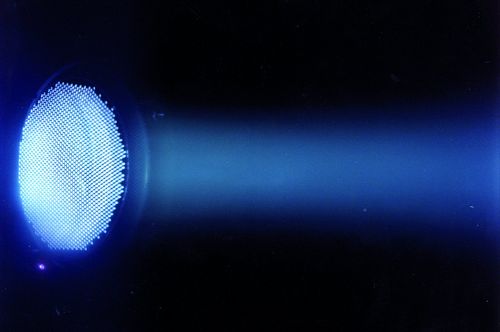Following a round of experiments, MIT researchers have discovered ion thrusters to be much more efficient as a source of propulsion than conventional jet engines.

Ion propulsion (Image via parabolicarc.com)
This new information could lead to all sorts of military and security benefits, as the technology is entirely silent and invisible to infrared.
Electrohydrodynamic thrust 101
Ion thrusters are based on a phenomenon referred to as “electrohydrodynamic thrust”, or “ionic wind” for short. There are three parts to your typical ionthruster: a thin copper electrode (emitter), a thicker tube of aluminum (collector), and the air gap between. A frame supports the wires, which connect to an electrical power source.
When voltage is applied, the field gradient takes electrons away from local air molecules. These suddenly ionized molecules are repelled by the corona wire and attracted to the collector. As a cloud of ions moves toward the aluminum, it collides with surrounding neutral air molecules, pushing them along.
This effect, in turn creates a wind, or thrust. If enough voltage is applied, the resulting wind can produce enough thrust to move a vehicle forward, without the help of motors or fuel.
Ionic wind was first discovered in the 1960s, but it was written off for various reasons, including the theory that ion thrusters used as jet propulsion would be extremely inefficient due to the believe that the technology would require a ton of electricity to produce enough thrust to propel the plane forward.
As such, ionic wind technology has largely been relegated to science-fair and hobbyist projects, with no actual studies of the technology taking place.
What the MIT researchers discovered about ionic wind
In a paper published in the Proceeding of the Royal Society, MIT researchers report that ion thrusters are actually far more efficient as a source of propulsion than conventional jet engines. Speaking numbers, they found that ionic wind produces 110 newtons of thrust per kilowatt, as compared to a jet engine’s 2 newtons per kilowatt.
Steven Barrett, an assistant professor of aeronautics and astronautics at MIT, co-authored the paper with graduate student Kento Masuyama. He foresee a scenario in which ionic wind is used as a propulsion system for small, lightweight aircraft, which would benefit, among other groups, the military, as the technology is silent, and since it gives off no heat, it’s also invisible in infrared.
“You could imagine all sorts of military or security benefits to having a silent propulsion system with no infrared signature,” Barrett said.
How the team took measurements
Barrett and Masuyama built a model similar to the one described above, with the only difference being that they hung their system under a suspended digital scale. Once everything was in place, they applied tens of thousands of volts to the system, creating enough current draw to power up an incandescent light bulb.
As they went further with the experiment, the duo altered the distance between the electrodes, and also recorded the thrust as the device lifted off the ground.
The time at which the technology was most efficient was when it was producing lower thrust – a desirable yet somewhat counterintuitive result.
“It’s kind of surprising, but if you have a high-velocity jet, you leave in your wake a load of wasted kinetic energy,” Barrett explains. “So you want as low-velocity a jet as you can, while still producing enough thrust.”
Outlook
While ion thrusters sound like a promising technology, thrust density remains a big hurdle for the technology. You see, ion thrusters rely upon the wind produced between electrodes: the larger the space, the stronger the thrust. This means lifting a small aircraft and its electrical power supply would necessitate an enormous gap between electrodes.
Barrett believes that electrodynamic thrusters for aircraft — should they ever get to the point that they could actually work — would take up the entire vehicle.
Also standing in the way of this technology: the voltage needed in order to get the vehicle off the ground. Small, lightweight models require several kilovolts. Barrett guesses that a small aircraft, complete with on-board instrumentation and power supply, would need hundreds, if not thousands, of kilovolts in order to just get up in the air.
“The voltages could get enormous,” Barrett says. “But I think that’s a challenge that’s probably solvable.” A solution he suggests is supplying the craft with lightweight solar panels or fuel cells.
Ned Allen, chief scientist and a senior fellow at Lockheed Martin Corporation, is not dismayed by the drawbacks of this technology, but instead believes it “offers nearly miraculous potential.” He adds, “[Electrohydrodynamic thrust] is capable of a much higher efficiency than any combustion reaction device, such as a rocket or jet thrust-production device.”
Barrett concludes, “Efficiency is probably the number one thing overall that drives aircraft design. [Ion thrusters] are viable insofar as they are efficient. There are still unanswered questions, but because they seem so efficient, it’s definitely worth investigating further.”
Story via: mit.edu
Advertisement
Learn more about Electronic Products Magazine





